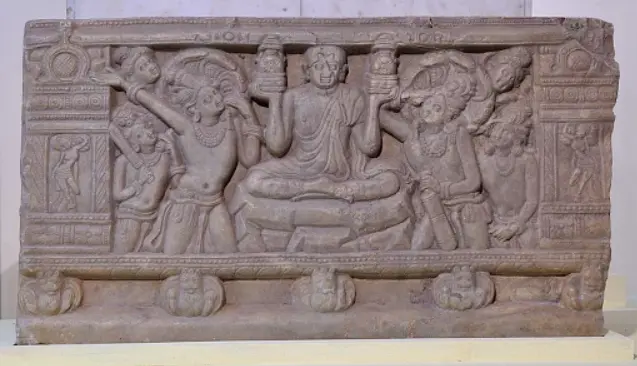Introduction
Between the third and fourth centuries CE, the Ikshvaku dynasty held sway over the eastern Krishna River valley in India, with their capital situated at Vijayapuri (modern Nagarjunakonda in Andhra Pradesh). To set themselves apart from their legendary namesakes, they are alternatively recognized as the Andhra Ikshvakus or the Ikshvakus of Vijayapuri. The Ikshvaku rulers, adherents of Shaivism and practitioners of Vedic rituals, presided over a period where Buddhism thrived. Notably, numerous queens and princes from the Ikshvaku lineage played instrumental roles in the construction of Buddhist monuments in present-day Nagarjunakonda. This discourse delves into the Ikshvaku Dynasty (225-340 AD), offering valuable insights for those preparing for the UPSC exam.
Ikshvaku Dynasty - Origin
- Ikshvaku Clan Origins:
- Ongoing debate surrounds the origin of the Ikshvaku clan.
- Numerous references provide insights into the emergence and continuity of the dynasty.
- Inscriptions and Documented Activities:
- Ikshvaku inscriptions found in Nagarjunakonda, Jaggayyapeta, Amravati, and Bhattiprolu.
- Documents activities such as donations, construction projects, religious practices, and social outlook.
- Puranic Mentions:
- Puranas refer to Ikshvakus as Andhrabhrtyas (Andhra servants) and Sriparvatiyas (Foresters).
- Sriparvatiya and Vijayapuri:
- In Ikshvaku inscriptions, "sriparvatiya" is linked to Vijayapuri (ancient capital) as "Sriparvate Vijaypur."
- Possible ancient name for the Nallamalai Range.
- Lineage Claims:
- Kannada poem Dharmamrita suggests Andhra Ikshvakus are descendants of renowned North Indian Ikshvakus.
- Authenticity debated, possibly propagated to elevate the tribe's status.
- Mythical Descent:
- Andhra Ikshvakus believed claiming descent from mythical Ikshvakus of Ayodhya, including Lord Rama, would endear them to subjects.
- Migration and Sovereignty:
- Oriental scholars (e.g., Buhler, Rapson) propose a narrative of northern Ikshvakus migrating southward and establishing sovereignty.
Art and Architecture
- Dual Religious Beliefs:
- Ikshvakus is known for embracing both Buddhism and Brahmanism.
- Reflected in their art and architectural projects.
- Inscriptions and Religious Practices:
- Records of donations for chaityas and viharas at Bhattiprolu and Jaggayyapeta.
- Construction of temples during various rulers' reigns, showcasing syncretic religious practices.
- Role of Ikshvaku Women:
- Inscriptions from Jaggapatteya, Kottampalugu, and Nagarjunakonda highlight royal Ikshvaku women as major Buddhist patrons.
- Funding Buddhist construction projects.
- Cultural and Religious Growth:
- Represents cultural and religious growth in the Krishna-Guntur region.
- Architectural Splendor:
- Mahachaitas, viharas, and ornate temples, especially at Nagarjunakonda, showcase support for Vedic and Buddhist faiths.
- Nagarjunakonda Excavations:
- Main site of Ikshvakus with advancements in architecture, religion, and sculptural techniques.
- Ikshvaku Citadel:
- Prominent structure at Nagarjunakonda.
- Well-fortified with rampart walls.
- Includes residential buildings, barracks, stables, baths, cisterns, and square walls.
- Speculated Palace Edifice:
- Unproven speculation regarding an edifice near Nagarjunakonda as the Ikshvaku palace.
- Traces of a moat outside the edifice's rampart support the hypothesis.
- ASI Stepped Tank Excavation:
- Stepped tank with water overflow mechanism discovered at Nagarjunakonda.
- Originally featured a wooden superstructure with lamps and hooks, according to an ASI study.
Sculpture
- The Ikshvakus' sculptures represent a declining phase in the art tradition starting with Amravati and Jaggapatteya art in the second century B.C.
- Ikshvaku art is considered the final chapter in the Satavahana art tradition, beginning around 230 B.C.E.
- During Virapurushadutta's reign, early carvings lacked the vigor of mature Amravati tradition and were in low relief.
- Stupas were plain, with no anthropomorphic depictions of Buddha, represented symbolically as a wheel, feet, and throne with Swastika.
- The mature phase featured sculptures with delicate poses and subtle expressions, often depicting Jatakas like the Mandhatu-jataka.
- Round figures appeared in the 11th regnal year of Ehuvala Camtamula, evidenced by a mutilated Buddha image at Nagarjunakonda's site 9.
- An evolved phase is seen in a long panel at site 106, dated to the 24th regnal year of Ehuvala Camtamula, featuring intricate depictions of mithuna figures and scenes from Gautama Buddha's life.
- Other sculptures from this period show bold relief and evolved features, including depictions of human emotions and expressions.
- Themes are drawn from Buddhist literature, featuring over a dozen Jataka stories, including Sasa Jataka, Mahapaduma Jataka, Vessantra Jataka, and Mahahamsa Jataka.
- Sculptures depict various scenes, such as Mara's attack and retreat, Muchalinda protecting Buddha, and moments from the Lalit Vistara.
- The mature style of Ikshvaku art is prominent in the Brahmanical tradition, showcasing intricately designed reliefs of Sati and Karttikeya sculptures carved in the ground.
- The secular art tradition is visible in battle scenes on pillars, indicating military challenges faced by Vijayapuri, the capital city of Ikshvakus, during the mature phase.
- Noteworthy scenes include the depiction of an elephant with a rider in King Kulhaka-memorial Chamtapula's work.

Conclusion
Hence, in the era when the nascent elements of Ikshvaku art took hold in the Krishna valley, approximately in the second quarter of the third century, the Satavahana art style or Amravati school of art was not at its zenith. However, during this period of ascent, the valley experienced both prosperity and remarkable growth, emerging not only as a hub of art but also wielding substantial political influence. Under Ikshvaku's fleeting rule, a diverse array of people with varying faiths and beliefs flourished, including royal women devoted to Buddhism and men adhering to the Vedic religion. The unchallenged dominance of the Ikshvakus, evident in grand structural endeavors and support for diverse artistic styles, concluded in the 11th regnal year of Rudrapurushadutta. Purushadatta II, the final monarch of the Ikshvaku lineage, faced deposition at the hands of Pallava ruler Simhavarman I.

